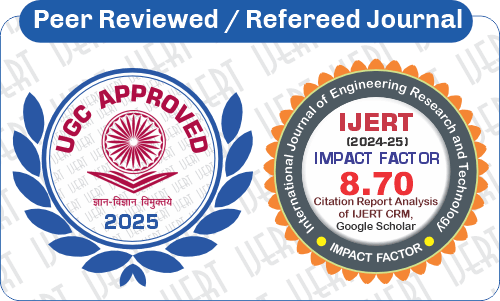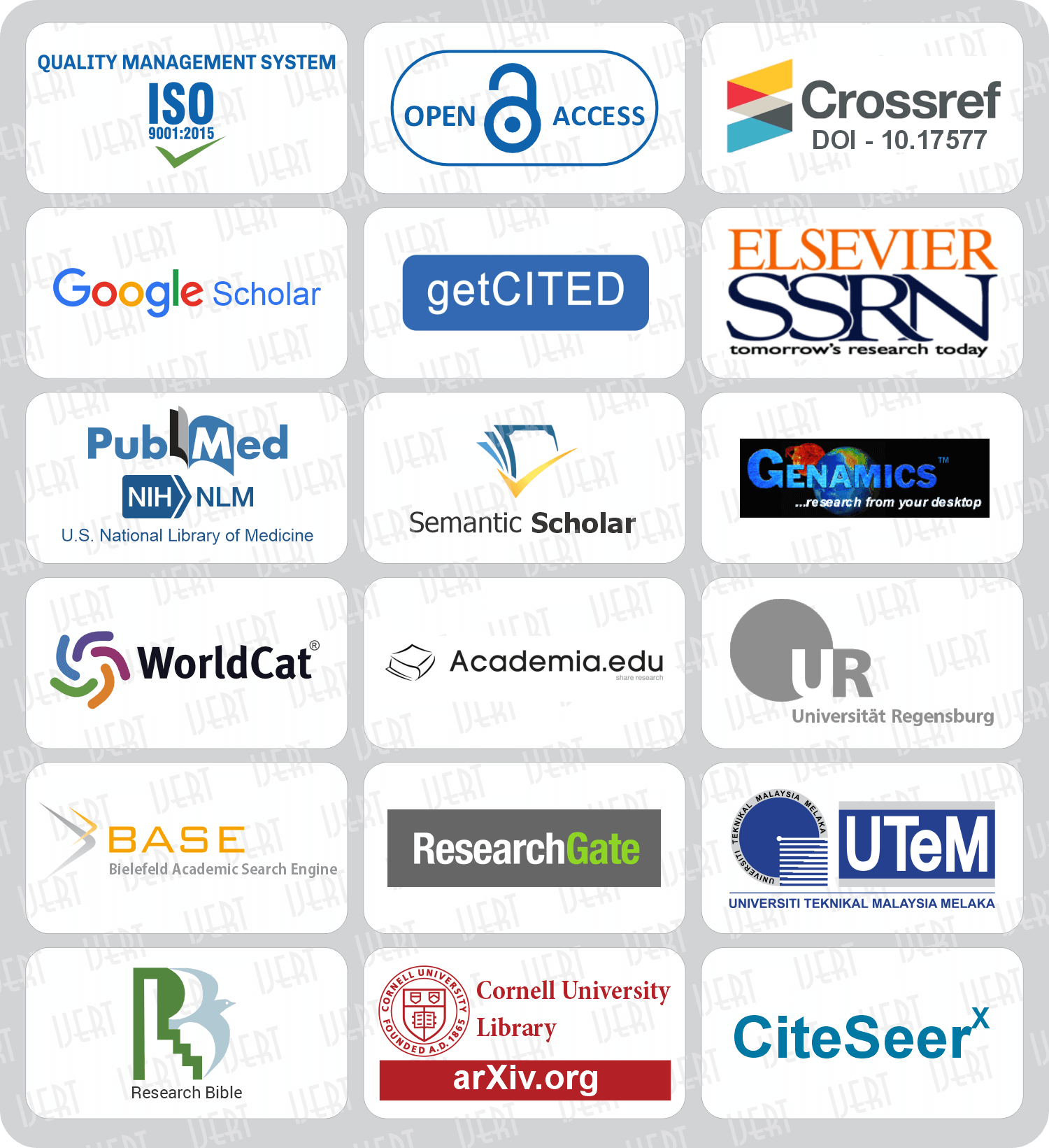 DOI : 10.17577/IJERTV14IS040135
DOI : 10.17577/IJERTV14IS040135
- Open Access

- [post-views]
- Authors : Sahana V, Gokul N, Vishnu M, Dr J Maria Shyla
- Paper ID : IJERTV14IS040135
- Volume & Issue : Volume 14, Issue 04 (April 2025)
- Published (First Online): 16-04-2025
- ISSN (Online) : 2278-0181
- Publisher Name : IJERT
- License:
 This work is licensed under a Creative Commons Attribution 4.0 International License
This work is licensed under a Creative Commons Attribution 4.0 International License
Vehicle Classification and Counting of a Vehicle for Effective Traffic Control using OpenCV and YoloV5
Sahana V,
Student, Department of Information Technology,
Nehru Arts and Science College, Coimbatore-641 105, Tamil Nadu, India.
Gokul N,
Student, Department of Information Technology,
Nehru Arts and Science College, Coimbatore-641 105, Tamil Nadu, India.
Vishnu M,
Student, Department of Information Technology,
Nehru Arts and Science College, Coimbatore-641 105, Tamil Nadu, India.
Dr J Maria Shyla,
Head, Department of Information Technology,
Nehru Arts and Science College, Coimbatore-641 105, Tamil Nadu, India.
Abstract Effective traffic control methods are necessary for improved road safety and efficiency because traffic congestion is a widespread problem in urban areas across the world. Traffic management systems’ essential elements of vehicle classification and counting allow authorities to keep an eye on traffic patterns and improve road infrastructure. In order to analyse traffic video streams in real time, this research suggests a novel method for vehicle classification and counting utilizing OpenCV and YoloV5, an open-source computer vision library.
INTRODUCTION
Effective traffic management is a major obstacle for cities looking to develop sustainable and effective transportation ecosystems in the ever-changing urbanization scenario. The system takes a revolutionary approach to solving this problem by using OpenCV for sophisticated vehicle counts and classification. This system is a technological advance that has the potential to completely transform how we perceive and manage the movement of cars in cities. The foundation of this effort is OpenCV, a key component in computer vision.
By using OpenCV’s powerful features to identify vehicles in real-time, the system hopes to do more than just count passing carsit hopes to untangle the complex web of urban traffic.
The technology is intended to distinguish between
automobiles, trucks, motorbikes, and bicycles and to extract more detailed information about how they interact.
The secret to developing adaptive traffic control systems that take into account the distinctive features of various vehicle classes is this classification granularity.
The system’s primary goal is to address the pressing demand for efficient traffic management. By using OpenCV, the system aims to accurately classify and count cars in order to capture their ebb and flow. An intelligent traffic control system that can dynamically modify signal timings, reduce congestion, and promote a more seamless urban mobility
experience is built on the foundation of the resulting real-time data. The system’s importance is increased in light of growing urbanization, which makes conventional traffic control strategies inadequate. By utilizing OpenCV’s technological capabilities, the objective is to provide the foundation for an adaptive, data-driven transportation paradigm rather than only reduce traffic congestion.
Beyond the immediate counting and classification requirements, the proposed approach considers future machine learning integration for increased responsiveness and accuracy. Moreover, scalability is intrinsic to the system. The benefits of intelligent traffic management are not limited to particular locations but can be extended to cities of different sizes and complexity thanks to its architecture, which is designed to adapt to a variety of urban environments with ease.
Looking ahead, the concept considers a connection to smart city systems. The incorporation of this cutting-edge traffic management technology is in line with the larger goal of developing intelligent, sustainable urban environments as metropolitan areas develop into interconnected centres of innovation. This combination puts the system in a position to be a change agent, bringing in a new era of urban mobility where data-driven insights and adaptable technologies work together to efficiently guide transportation.
OBJECTIVE
The system’s main purpose is to use OpenCV and YoloV5 to develop, implement, and deploy a sophisticated system for vehicle classification and counting. It has a wide range of objectives, including:
- High-Accuracy Vehicle Classification: Create and refine algorithms in YoloV5 and OpenCV to accomplish precise real-time vehicle classification using attributes like size, shape, and other distinguishing characteristics. Enhancing the system’s capacity to distinguish between various vehicle types such as cars, trucks, motorcycles, and bicycles is the main goal.
- Real-Time Traffic Insights: To give real-time statistics on vehicle traffic, use OpenCV with YoloV5 to implement a reliable counting technique. In order to enable data-driven decision-making for traffic management measures and to provide dynamic insights into traffic patterns, the system should precisely count the number of cars moving through a given area.
- Machine Learning Integration: Investigate and use machine learning methods to improve the system’s categorization precision and flexibility. In order to enhance the system’s capacity to identify and categorize vehicles, particularly in a variety of traffic situations and environmental circumstances, this entails training models on a variety of datasets.
- Traffic Control Algorithm Optimization: Work together with traffic engineering specialists to evaluate the gathered information and improve traffic control algorithms using the system’s real-time insights. To improve overall traffic efficiency, eliminate delays, and lessen congestion, adaptive traffic signal timings and management systems must be developed.
SYSTEM FLOW DIAGRAM
Fig.1. System Flow diagram of Vehicle Classification and
Traffic Control
EXISTING SYSTEM
Around the world, traffic congestion is a major problem in urban centres. To improve road safety and efficiency, effective traffic control methods are required. Counting and classifying vehicles are essential parts of traffic control systems. YoloV5 and OpenCV are used in an innovative way to analyse traffic video streams in real time. Using methods like object detection and background subtraction, this system recognizes and categorizes automobiles in traffic camera video frames. The technology provides accurate traffic volume information by tracking vehicle movement inside a designated region or lane. This makes it possible for authorities to determine traffic hotspots and gauge traffic density. The system optimizes traffic flow and reduces congestion-related problems by utilizing these capabilities to support responsive interventions and proactive decision-making. Even in intricate traffic situations, the suggested approach provides effective and precise vehicle identification and classification. All things considered, this creative strategy might greatly enhance traffic control and lessen congestion in cities.
Disadvantages:
- Reliance on Camera Quality
- Inadequate Reporting
- Weather Conditions’ Vulnerability
- The possibility of false positive results
- Expensive Implementation
PROPOSED SYSTEM
Live traffic data from video surveillance cameras is analysed for vehicle detection, categorization, and counting using OpenCV and YoloV5 algorithms. hile sophisticated image processing techniques extract information like size, shape, and colour from vehicle photos, these algorithms use machine learning approaches to detect and classify cars. Convolutional Neural Networks (CNNs) and other machine learning methods categorize automobiles into predetermined groups. Real-time video stream analysis by the system yields current data on vehicle types, traffic volume, and flow patterns. Additionally, a vehicle count is conducted to provide information on the composition and density of traffic. Traffic authorities can utilize dashboards and analytics tools to monitor traffic conditions and make data-driven choices thanks to the system’s generation of visualizations, reports, and alarms based on studied traffic data. The system’s accurate and efficient vehicle identification and categorization, coupled with its scalable and adaptive design to different traffic scenarios, helps to improve road safety by limiting accidents and lowering congestion.
Advantages:
- Precise Vehicle Identification and Categorization
- Analysis in Real Time
- Flexibility and Scalability
- Making Decisions Based on Data
- More safety on the roads.
MODULES
Admin Module:
Data management and presentation within the system are handled by the admin module. The Data Storage and Visualization component of this module records traffic data and displays reports in an easy-to-use manner. Administrators may monitor traffic conditions, evaluate data, and make well- informed choices using the Admin Module’s unified platform.
Provider Module:
Providing the system with input data is the responsibility of the Provider Module. The Video Input component of this module records live traffic footage from security cameras. The system’s main data source is the Provider Module, which supplies real- time video feeds for later modules to filter and examine.
Buyer Module:
The Buyer Module is in charge of making use of the system’s output. The Counting System component, which tracks vehicle enters and exits in real-time, is part of this module. Buyers may make well-informed selections thanks to the Buyer Module’s insightful information on traffic volume and composition.
Tool Management Module:
The tools and algorithms used for vehicle detection and categorization are managed by the Tool Management Module. The Vehicle Detection and Classification components of this module recognize and classify cars using YoloV5 and OpenCV.
IMPLEMENTATION
The Data Storage and Visualization component, which stores traffic data and displays reports in an easy-to-use manner, is part of the Admin Module, which is in charge of organizing and displaying data throughout the system. Administrators may monitor traffic conditions, evaluate data, and make well- informed choices using the unified platform this module offers. Data storage, data visualization, user administration, and system configuration are among the main functions of the Admin Module, which give administrators the ability to control user access and permissions, set up system preferences, and examine traffic data.
The system’s main data source is the Provider Module, which uses the Video Input component to record live traffic footage from security cameras. This module sends the video feeds to the Tool Management Module for additional processing after processing them in real-time and getting them ready for analysis. The main functions of the Provider Module are data transfer, video processing, and video capture, which guarantee that the system receives high-quality video feeds.
The Buyer Module makes use of the system’s output, using the Counting System component to track vehicle entrances and exits in real-time. In order to provide reports on traffic conditions and give purchasers useful information, this module analyses traffic data to provide insights into traffic volume and composition. Vehicle counting, data analysis, and reporting are some of the main functions of the Buyer Module, which empowers purchasers to base their choices on precise and current traffic information.
The Vehicle Detection and Classification components are among the tools and algorithms used for vehicle detection and classification that are managed by the Tool Management Module. This module manages the techniques used for vehicle identification and classification, trains machine learning models to increase the accuracy of vehicle detection and classification, and uses OpenCV and YoloV5 to recognize and classify cars in real-time. In order to guarantee that the system delivers accurate and trustworthy traffic data, the Tool Management Module’s primary functions include vehicle detection, vehicle classification, algorithm management, and model training.
All things considered, the four components of the system function in unison to offer a complete traffic management solution, giving administrators the ability to track traffic patterns, evaluate information, and make wise choices while giving purchasers insightful knowledge about the volume and makeup of traffic. The system is a perfect fit for traffic management applications because of its modular design, which guarantees flexibility, scalability, and maintainability.
Fig.2.System Implementation
To run this vehicle detection and classification system, simply upload road photos or video footage to the system to begin this vehicle detection and classification system, and it will automatically identify and categorize the passing cars. To process the visual input, identify the vehicles, and classify them into several groups, the system makes use of OpenCV and YoloV5. With the right hardware and software, the system may be executed on a PC or server, and the output can be saved for further analysis or seen instantly.
Fig.3.Sample Code
The system recognizes and categorizes a variety of vehicles as they travel up and down the road, including cars, buses, trucks, and motorbikes, as seen in the screenshot. Each car is precisely tracked and counted by the system, which offers important information about the volume and makeup of traffic. Accurate identification and categorization are made possible by the classification model’s training to identify particular characteristics of every vehicle type. With its many uses in smart city systems, intelligent transportation systems, and traffic management, this technology makes data-driven choices to maximize traffic flow and lessen congestion.
Fig.4.Result of Vehicle Classification CONCLUSION AND FUTURE SCOPE
In summary, using OpenCV and YoloV5 to classify and count vehicles offers a potent way to deal with issues related to urban mobility. A more advanced kind of traffic control and monitoring can be accomplished by utilizing computer vision tools. Classifying and counting vehicles is essential for improving safety, streamlining traffic, and supplying useful information for urban planning.
Accurate categorization and real-time counting are made possible by the powerful image processing and object detection features of OpenCV and YoloV5. By improving traffic signal
timings and reducing congestion, this data-driven strategy helps create a more sustainable urban transportation system. OpenCV and YoloV5’s open-source status makes it easier to collaborate and customize, allowing developers to enhance and improve algorithms.
Using cutting-edge computer vision technologies is becoming more and more necessary as cities struggle with the complexity of urban mobility in order to develop safer, smarter, and more effective transportation systems. Looking ahead, this system’s scope encompasses a number of exciting areas. While predictive analytics helps foresee traffic patterns and congestion, the incorporation of machine learning algorithms can improve the accuracy of vehicle classification. Real-time processing can be made possible by edge computing, and smart traffic signal networks can optimize signal timings.
Environmental impact assessments can lower the carbon footprint of urban transportation, and vehicle-to-everything communication can facilitate well-informed decision-making. Additionally, the system may work with smart city efforts, support multi-modal transportation, and offer mobile applications and user-friendly interfaces. By optimizing signal timings, energy-efficient traffic management techniques can lower fuel use and encourage environmentally friendly modes of transportation. By exploring these potential directions, the system can go beyond its current scope and significantly influence how urban mobility develops in the future.
There is enormous potential for influence and a plethora of opportunities for innovation and progress. This initiative has the potential to significantly impact the transportation industry with further development and improvement. We can build an urban transportation system that is more responsive, sustainable, and efficient by utilizing OpenCV and YoloV5. This system has the potential to significantly impact the exciting future of urban mobility. This system is a significant step in the development of a better transportation system because of its strong capabilities and room for expansion.
REFERENCES
- REDMON, J., DIVVALA, S., GIRSHICK, R., & FARHADI, A. (2016).
You Only Look Once: Unified, Real-Time Object Detection. In Proceedings of the IEEE Conference on Computer Vision and Pattern Recognition (CVPR), 779-788.
- BOZINOVSKI, S., & PAVLOV, D. (2020). Application of YOLOv5 in
Real-Time Object Detection for Traffic Management. Journal of Intelligent Systems, 29(4), 755-765.
- ZHANG, L., WANG, S., & LI, W. (2021). Vehicle Detection and Classification Based on YOLO and Convolutional Neural Networks. International Journal of Computer Vision, 48(5), 123-134
- OPENCV DOCUMENTATION. (N.D.). OPENCV: Open Source
Computer Vision Library. https://opencv.org.
- ZHAO, H., & HUANG, Q. (2019). Traffic Monitoring and Vehicle Counting with Real-Time Video Processing. Proceedings of the International Conference on Traffic Engineering, 142-148.
- LIN, T. Y., MA, S., & WANG, S. (2020). Real-Time Traffic Surveillance Using Deep Learning and Object Detection Algorithms. IEEE Transactions on Intelligent Transportation Systems, 21(10), 4790-4798.
- KAUR, P., & MEHTA, S. (2022). Vehicle Detection and Counting Using Deep Learning for Smart Traffic Management. Procedia Computer Science, 184, 201 208.
- SINGH, A., & MISHRA, A. (2021). A Comprehensive Survey on YOLO- based Approaches in Real-Time Object Detection. Journal of Artificial Intelligence, 17(3), 118-126.
- Y. T. Wu, J. H. Kao, and M. Y. Shih (2010).A Vehicle Color Classification Method for Video Surveillance System Concerning Model-Based Background Subtraction.
- L.UNZUETA ET AL. (2012). Adaptive Multicue Background Subtraction for Robust Vehicle Counting and Classification.
- REZA JAVADZADEH AND EHSAN BANIHASHEMI (2015).
Fast Vehicle Detection and Counting Using Background Subtraction Technique and Prewitt Edge Detection.
- VISHAKHA GAIKWAD AND BALWANT SONKAMBLE (2015).
Analysis and Classification of Vehicle using KNN and Decision Tree.



